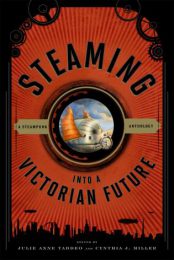After all, Steampunk as a genre of literature, fashion, film or even music is a truly young being, hardly older than 30 years, if we consider William Gibson’s and Bruce Sterling’s novel The Difference Engine (1990) as one of the very earliest works of fiction now considered part of the movement and probably its kick starter. The novel enjoyed rather moderate popularity outside the Steampunk community. Its literary forefathers, however, are famous. These are the works of H. G. Wells and Jules Verne.
 The anthology at hand pays attention to the many variations of the movement and devotes each of the fourteen chapters to one of the aforementioned genres and its compilers, author and teacher Julie Taddeo and Cynthia Miller, editor of the Film and History Series for publisher Rowman and Littlefield, have arranged the first compilation of academic texts on the subject.
The anthology at hand pays attention to the many variations of the movement and devotes each of the fourteen chapters to one of the aforementioned genres and its compilers, author and teacher Julie Taddeo and Cynthia Miller, editor of the Film and History Series for publisher Rowman and Littlefield, have arranged the first compilation of academic texts on the subject.
However, the sixteen texts differ strongly in both their language and depth. What we get is some very well-researched texts but also some texts handed in by fans and Steampunk ravers, it seems, that they sometimes lack the depth of scholarly research. But then again, there is not a chair of Steampunk Research at any department yet, so we must “take what we can get” in terms of written material on the subject.
The emphasis after all is on literary texts, since novels and short stories have proven to be one of the movement’s strongest forms of expression. It is maybe interesting to learn that of the altogether 15 contributors, 10 are female (including the two editors); which may have to do with the fact that Steampunk embraces so many of the fine arts and crosses many borders from literary criticism over fashion to feminist approaches to style, dress and the roles and the possibilities of women in the Victorian age, a period that is not just referred to permanently in the fiction, science fiction and fantasy blends, but also reappears and is quoted by all kinds of instances, be it the corset, expensive dresses of the occasional time traveler in some novels who experiences different modes of womanhood. Furthermore, by now there exist a number of Steampunk novels that feature heroines and are written by women; this too is a new development, since the early novels of the genre were written by men exclusively.
As all the essays point out, Steampunk borrows content from Victorian fashion and design, as well as from machine age design and inventions. Nevertheless, the unlimited possibilities to combine those elements with anything modern or even pre-Victorian leaves a lot of room for new interpretations, for example, fashion, music and design. Steampunk then is both a “blending” device as well as a unique ingredient of the many variations its fans compose, so it could also be called a mere “common denominator,” rather than a movement. This is illustrated by the many references to the DIY approach in the essays at hand to anything Steampunk.
At the same time, this is one of the greatest properties of the movement, since actually anybody can reproduce, redesign and invent machinery, apparel and other material goods, let alone fictional accounts of alternate pasts and societies, alloyed between the present and fictional technological societies that never quite abandoned the steam engine. And thus fans produce wonderful artifacts both fictional and material.
Since technology strongly influenced society in the age of industrialism, any number of social developments did not happen or happened quite differently in the many Steampunk stories. For lack of technology did not allow entire social modifications and left whole branches of society in a Dickensian state of existence.
However, I am still wondering if this really is “the core” of the Steampunk phenomenon. I do not mean the anthology, but the trend that is depicted. After all, there are only a few movies, a small number of literary works and some bands that may or may not pick a Steampunk stage outfit. The bibliography to me seems way too small to define a valid canon, but then a small cannon must suffice; but is that “truly everything” there is to know about Steampunk?
All in all, this is a good overview of the many aspects of the movement. Let us not forget that a major part of all trend activities, shows, craftsmanship displays, publications and discussion are on display online and can easily change the whole course of the multifaceted genre in mere weeks. This fact – strange as it is – may call for another printed volume with an update.
(This text is about the reprint from 2014. The book was originally published in 2012.)
Review by Dr. A. Ebert © 2015
Julie Anne Taddeo and Cynthia J. Miller (eds.) Steaming Into a Victorian Future. Rowman & Littlefield, 2014, 360 p.
